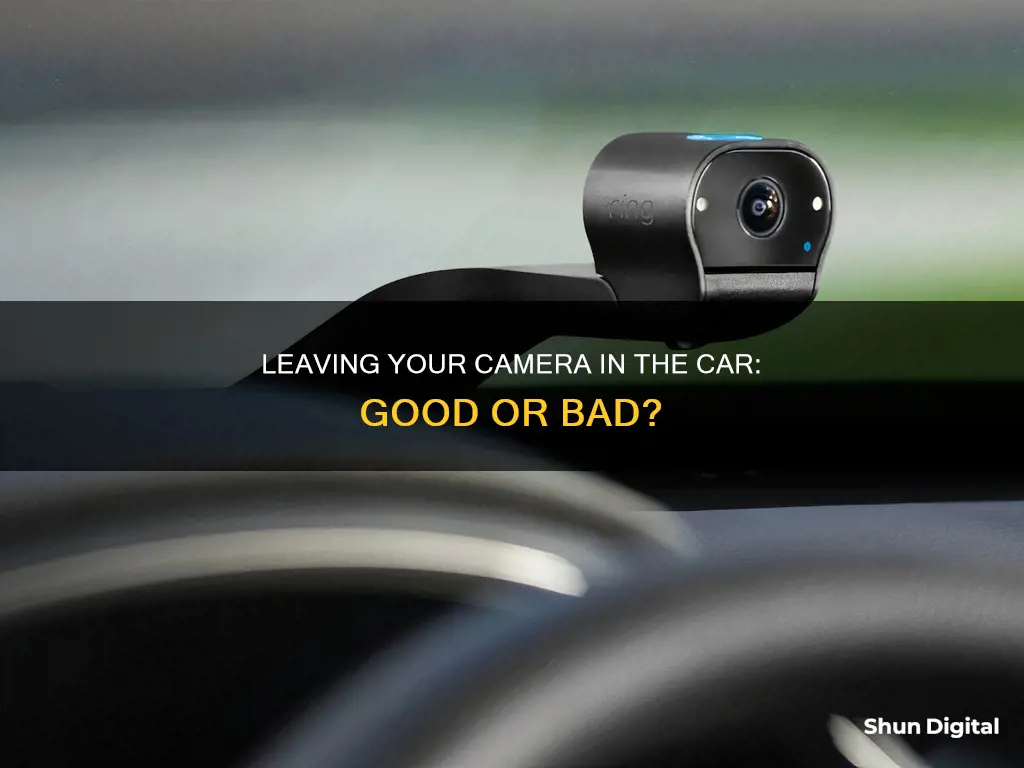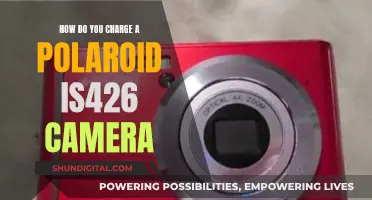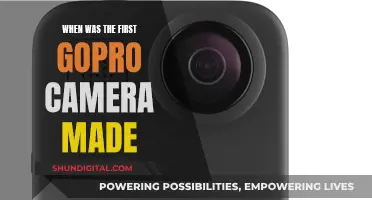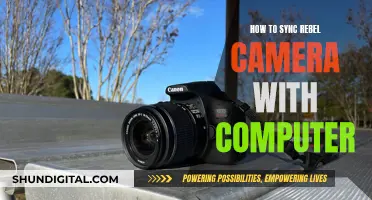
Leaving your camera in the car overnight can be risky. Extreme temperatures can damage your camera's electronics, and drastic temperature changes can cause condensation to form, which can lead to moisture getting inside your camera. In addition, visible cameras can be a target for thieves, and leaving your camera in the car can drain your car's battery. However, some people choose to keep their cameras in their cars, and there are steps you can take to mitigate these risks, such as keeping your camera out of direct sunlight, concealing it from view, and parking in a well-lit area.
| Characteristics | Values |
|---|---|
| Can leaving a camera in a car overnight damage it? | Extreme cold can drain the battery and cause condensation. Extreme heat can cause damage to the camera's most delicate parts. |
| Can a camera be left in a car overnight? | It is not recommended due to the risk of theft and damage. |
| How can damage be prevented? | Keeping the camera in a sealed bag can prevent condensation. Keeping the camera out of direct sunlight and in a separate trunk compartment can prevent heat damage. |
What You'll Learn

Extreme temperatures can damage your camera
Extreme temperatures can indeed damage your camera. Intense heat or cold can cause your camera to temporarily malfunction or even suffer permanent damage. Most cameras are rated to work between -10 and +40 degrees Celsius (14-104 degrees Fahrenheit). This is generally not because of the camera itself, but because of the batteries – the chemicals inside of them cease to work properly when they get too cold or too hot.
To avoid this problem, keep an extra battery in a temperature-controlled place. If you’re shooting in the cold, keep one in your pocket to be warmed by your body heat. In the heat, your camera bag should provide adequate shade to keep a battery cool enough to function.
Never place your camera face up in direct sunlight. The lens works both ways and can act like a magnifying glass to focus the rays into your camera and burn a hole in your shutter and eventually your image sensor. Remember that even magnesium-alloy cameras contain plastic components, so if you shoot in really extreme places, such as near volcanoes or among raging fires, use common sense and keep your camera away from the flames.
In temperatures of more than 38 degrees, give the camera periodic rests in an air-conditioned environment. Elements such as the batteries, image sensors, and LCD screen can easily overheat. Use an AC adapter kit and limit your use of the LCD by using an external monitor or the viewfinder.
If you venture out in negative temperatures, you’ll find frost develops on your camera quite quickly. If your camera has frozen or developed frost all around it, put it straight in your camera bag and don’t open it again until the morning. Give it a good long rest in the bag to slowly adjust to a warmer temperature.
The inside of your camera can get hotter than the outside temperature, so keep heat-generating functions like batteries and the LCD screen to a minimum in hot environments.
Traffic Cameras on Route 61, PA: Ticket or No Ticket?
You may want to see also

Thieves may break into your car and steal your camera
Keeping your camera in the car overnight may increase the risk of theft. If thieves see a camera in your car, they may be tempted to break in and steal it. Even if your camera is hidden, thieves may break in to see if there is anything valuable hidden in the car.
To reduce the risk of theft, you can keep your camera out of sight, such as in the trunk of your car, and avoid leaving anything visible in the cabin that might attract attention. You can also check with your insurance provider to see if your policy covers theft of expensive gear from cars and if there are any specific conditions you need to meet, such as keeping the camera in the trunk or providing evidence of forceful entry.
Additionally, it is important to consider the temperature extremes your car may experience, as both heat and cold can potentially damage your camera. While some photographers have reported leaving their cameras in hot cars without any issues, others have experienced problems such as lens element coming loose, noisy images, and peeling trim. Extreme temperatures can also affect the battery life and cause condensation issues when moving between hot and cold environments.
To protect your camera from temperature extremes, avoid leaving it in direct sunlight and consider storing it in an insulated bag or container, especially during the summer months when temperatures can exceed 100°F (38°C). You can also cover your camera bag with a towel that matches the color of your car's interior to provide some protection from the sun and add a layer of camouflage.
Charging Your Camera: Dead Rising Guide
You may want to see also

Condensation can damage your camera
Condensation forms when warm air meets a cold surface. When that air cools down, its ability to carry moisture reduces, so the water will cling to the nearest surface. This can be the outside of your lens, or the inside of your camera. Condensation on the outside of your lens won't cause permanent damage, but it's still a good idea to take steps to prevent it. Condensation inside your camera, on the other hand, can be very damaging.
To prevent condensation, acclimation is key. When moving your camera between environments with different temperatures and humidity levels, make sure it's securely in your camera bag with all zippers closed. The padding in your camera bag will help to insulate your camera, regulating sharp changes in temperature and allowing your gear to acclimate slowly. Depending on the temperature differences and the size of your gear, you may need to leave your camera in the bag for several hours. For extra protection, place your camera inside a plastic ziplock bag before putting it in your camera bag.
If your camera already has condensation on it, don't wipe the lens, as this will leave streaks. Instead, put your camera in an airtight bag and wait for the condensation to dissipate naturally. You can put something in the bag to wick moisture away, such as a towel or uncooked rice. For severe cases, use silica gel packs to help dry out internal components.
Glass Cameras: S10e's Unique Feature
You may want to see also

Extreme temperatures can reduce battery life
Keeping your camera in the car overnight can have adverse effects on its battery life, depending on the temperature.
The standard rating for batteries is at room temperature, 25°C (77°F). At -22°F (-30°C), battery capacity drops to 50%. At freezing, capacity is reduced by 20%. Conversely, at 122°F, battery capacity is about 12% higher, but battery life is shortened. For every 15°F over 77°F, battery life is cut in half.
Therefore, it is best to avoid exposing your camera to extreme temperatures, whether hot or cold, to preserve its battery life.
Charging Eufy Cameras: A Step-by-Step Guide
You may want to see also

Your camera may be damaged by UV exposure
Keeping your camera in the car overnight can be harmful to your equipment in several ways. One of the most prominent issues is the potential for UV exposure, which can cause severe damage to your camera.
The sun's ultraviolet rays can be intense, and leaving your camera in a car overnight means it will be exposed to these rays for an extended period. While your camera may be designed to withstand some UV light, prolonged and excessive exposure can have detrimental effects.
Damage to the Camera Lens and Coating
The intense UV rays can affect the camera lens, causing haze and other optical problems. The lens coating may break down over time, impacting the lens's performance and image quality. While UV filters can provide some protection, they may not be sufficient in extreme temperatures.
Internal Circuitry Damage
UV light can also damage the internal circuitry of your camera, leading to potential short circuits. This can result in a loss of picture quality or even render your camera inoperable. The risk of internal damage is heightened if your camera is exposed to direct sunlight or high temperatures for extended periods.
Image Sensor Damage
The image sensor in your digital camera can be affected by UV light, causing fuzzy or distorted images. The colour balance may also shift, resulting in inaccurate colour reproduction in your photographs.
Reduced Camera Functionality
Prolonged UV exposure can cause a gradual decline in your camera's overall functionality. This includes issues such as cloudy or foggy lenses, distorted images, and a decrease in picture quality. While most cameras have built-in UV filters, they may not provide complete protection, especially in extreme conditions.
Increased Susceptibility to Other Forms of Damage
UV exposure can weaken certain materials in your camera, making it more vulnerable to physical damage. For example, the exterior finish may fade, and some materials may become brittle, increasing the chances of breakage.
To minimise the risk of UV damage, it is recommended to avoid leaving your camera in the car overnight or for extended periods. If you must keep your camera in the car, store it in a protective case, preferably in the trunk or a separate compartment away from direct sunlight. Additionally, using a UV filter on your lens can provide some extra protection against UV rays.
Car Dash Cameras: Are They Legal to Use?
You may want to see also
Frequently asked questions
Keeping your camera in the car overnight is not recommended due to the risk of theft, extreme temperatures, and condensation. However, if you decide to do so, take precautions such as concealing the camera, parking in a secure area, and using a climate-controlled case to protect it from damage.
Extreme heat can damage sensitive camera parts, adhesives, and lubricants. It can also cause the camera's exterior finish to fade and weaken. On the other hand, extreme cold can drain the battery quickly and cause condensation issues when moving between cold and warm environments.
To reduce the risk of theft, keep your camera hidden from view, lock it in the trunk or glove compartment, and park in a well-lit and secure area. Additionally, consider getting insurance for your camera equipment to cover any potential losses.
To prevent condensation, avoid moving your camera directly from a cold environment to a warm, humid one. Keep the camera in a sealed plastic bag or a climate-controlled case, and allow it to acclimate to the new temperature gradually.







